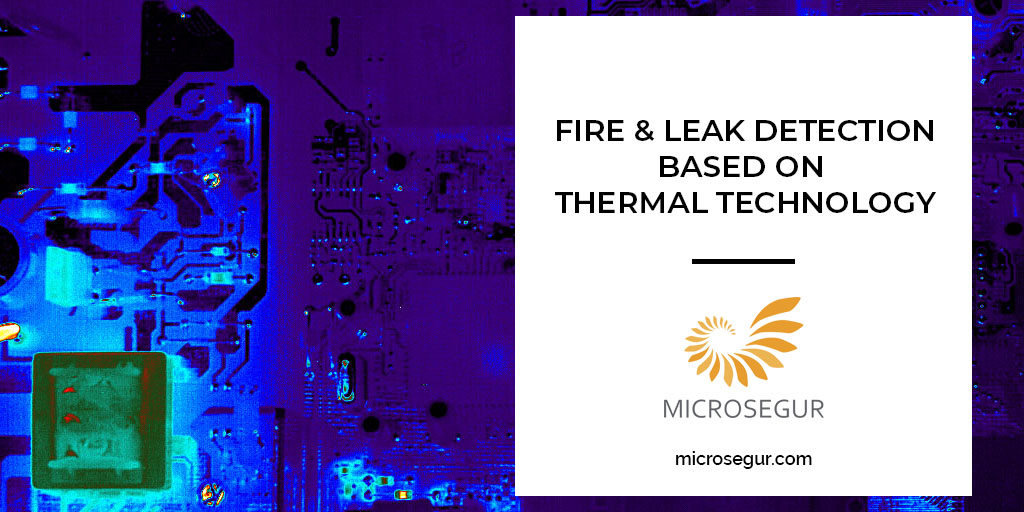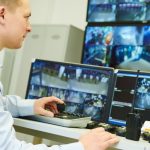Outdoor Fire and Leak Detection System based on thermal technology
Thermographic cameras are one of the decisive breakthroughs in detection of fires. The use of permanent temperature monitoring systems by way of thermographic cameras for complex environments is expanding: ATEX areas, storage of fire sensitive raw materials (coal, wood…).
At MICROSEGUR, we offer our clients the possibility of installing a high technology fire detection system. Again, following a customised study and design, we will implement the perfect solutions, using conventional technologies and detectors, along with others of the latest generation based on thermal and thermographic cameras and CCTV, which have as their objective, early detection of external fires, as well as gas leakage, and the subsequent actions for extinction and monitoring.
This type of camera shows the temperature of an object in the form of a thermal image, allowing the identification of different temperatures, analyzing abrupt changes in temperature, the elevation of temperature, if above certain thresholds, as well as a clear and graphic display of the distribution and development of temperature in a given area.
FEATURES
Thermographic cameras can be used to handle a wide variety of tasks in perimeter security and early detection of fires in several environments: industrial, ATEX areas, chemical, logistics, timber industry, commercial… as well as early detection of a gas leak. Many of these tasks are carried out in areas with a real and high risk. The main functionalities of thermography are:
- Fire Detection
Cameras works much like a flame or smoke detector notifying the existence of fire in the very early stages of the ignition process. In addition, thermal cameras detect what are known as slow fires, extremely dangerous because they do not produce light emission. A security system with thermographic cameras allows rapid detection of any fire in remote environments or isolated areas, far from populated areas and operating 24 hours a day. And they even do it under adverse weather conditions. Thus, the system will continue operating in dense fog, smoke or darkness, because this technology maintains very high operational levels.
- Leak Detection
Leakage of hazardous substances are one of the most frequent accidents in chemical installations and often generate serious damage in own equipment, in people exposed and in the environment. Another signifiant impact is the interruption of the production process, including, in some cases installation drainage, evacuation of plant and civilian areas located near it. Leakage can be of many types in accordance with the characteristics and the overall condition of the fluid: leakage of liquid gases (propane, butane…), corrosive liquids, inflammable substances, volatile toxic substances.
The consequences of these leaks are extremely serious and are considered as force majeure cause. Our security system with thermography application can detect with precision and remotely all kinds of leaks in tanks, pipelines and facilities before problems occur and the service is affected, thereby improving security and profitability, and minimising emission. In addition they perform a thermal fault analysis that are presented in the places where there is a leakage.
- CO2 leakage detection. We have optical cameras to detect CO2 leaks quickly, easily and precise. This can be of vital importance to make its operations more efficient and safe, with minimal downtime for industrial facility.
- Gas and oil leakage detection. Such as natural gas or liquid petroleum gas (LPG), fuels widely used in industrial sectors, commercial, residential and vehicular transport. Great variety of industrial gases and chemical compounds are invisible to human eyes, even so our system of thermal cameras are able to detect when the leak happens.
- Supervision of plants that are difficult to reach with measurement tools into contactComprobación de la alarma mediante la visualización directa
- Check alarm by means of direct visualisation, through image provided by the camera.
Preventive Maintenance
Thermography is one of the most valuable diagnostic instruments for preventive maintenance in industrial facilities. It allows corrective actions before costly system failures occur, because it detect faults that are often invisible to the naked eye.
Preventive maintenance consists in scheduling of work necessary to maintain equipment in optimum operating conditions, minimizing the incorrect operation and equipment failures while maintaining optimal production performance and safety conditions of the facilities. Through the revision of thermal images of the equipment under study, decisions on whether an item should be repaired or replaced are most effective, reduce overall costs and increase equipment reliability. This results in greater efficiency of the plant in general.
Industries throughout the world have discovered the advantage of incorporating thermal cameras into their preventive maintenance programmes.
Predictive Maintenance
Predictive Maintenance is mostly used in high-cost equipment or whose operation is critical in facilities. Thermographic cameras are powerful tools non-invasive for the supervision and diagnostic of the condition of components, and electrical and mechanical installations.
Thus, in the case of an inspection of large industrial facilities, a thermography with accurate temperature data provides the maintenance manager important information about the status of equipment inspected. Furthermore, these installations can be performed while the production process is fully operational and, in many cases, the use of a thermographic camera can even help optimize the production process itself.
Advantages are decreased equipment downtime, increased uptime, return on investment in terms of reliability of maintenance and cost saving thanks to reduction in working hours.
Applications of thermographic cameras in industrial safety
- Control in refinery processes, energy generation plants, cement plants…
- Industries, particularly oil and gas (LPG tanks) depends on thermography to avoid costly and dangerous emissions.
- Ability to detect in ATEX zones, often with equipment most economical because they are located outside the own areas ATEX.
- Permanent monitor of furnace walls, tanks and pipelines.
- Continuous monitoring of temperature in critical elements of electrical substations.
- Fire detection in storage areas for raw materials (coal, wood, paper…).
- Location and fire detection in tunnels and waste treatment plants.



